Abstract
This study aimed to evaluate the electromyographic activity of the orbicularis oris muscle in patients using clinically inadequate conventional dentures before and after the insertion of clinically acceptable new convencional denture. Six patients, using inadequate dentures, were asked to pronounce the syllables PAH, BAH, MAH, SAH, FAH, VAH, MEE and the word MISSISSIPI. During this activity, we analyzed the Electromyographic activity of the orbicularis oris muscle. This was done before and after changing the inadequate denture for a acceptable new denture. A K6-I EMG Light Channel Surface Electromyograph was used (Myo-tronics Co). Results were analyzed by repeated measures ANOVA, with 3 sources of variation (Syllables, Muscles, and Clinical Conditions). ANOVA revealed higher electromyographic readings in the mandibular fascicle of the orbicular oris muscle, as compared to those of the maxillary fascicle (F = 79.02; P<0.01). The comparison regarding clinical conditions indicated higher electromyographic values after insertion of acceptable new denture (F= 32.64; P<0.01). Clinical condition after the implantation of a new well-adapted complete denture revealed higher electromyographic activity levels than those measured with the use of maladapted complete dentures.References
Moyers RE. Temporomandibular muscle contraction patterns in angle class II, division I malocclusions: an electromyographic analysis. Am J Orthod 1949; 35: 837-57.
Basmajian JV, De Luca CJ. Muscles alive: their function revealed by electromyography. 5th ed. Baltimore: Williams and Wilkins; 1985. p.276-82.
Regalo SCH, Vitti M, Hallak JEC, Semprini M, Mattos MGC, Tosello DO, et al. Analisis of upper and lower fascicles of the orbicularis oris muscle in deaf individuals. Electromyogr Clin Neurophysiol 2003; 43: 367-72.
Warner RA. Functional influences on structure and structural influences on function. Int J Orthod 1976; 14: 24-8.
Bassi F, Schierano G, Marinacci. Preliminary study of the rest position and the minimal phonetic distance in edentulous patients rehabilitated with prosthesis with modification of the palatal thickness. Min Stomatol 1999; 48(6suppl 1): 21-7.
Ingervall B, Redegard B. An eletromyographic study of mastigatory and lip muscle function in patients with complete dentures. J Prosthet Dent 1980; 43: 266-71.
Tosello DO, Vitti M, Berzin F. EMG activity of the orbicular oris and mentalis muscles in children with malocclusion, incompetent lips and atypical swallowing-part I. J Oral Rehabil 1998; 25: 838-46.
Tosello DO, Vitti M, Berzin F. EMG activity of the orbicularis oris and mentalis muscles in children with malocclusion, incompetent lips and atypical swallowing-part II. J Oral Rehabil 1999; 26: 644-9.
Farret SM, Vitti M, Farret MMB. Electromyographic analysis of the mentalis and depressor labii inferior muscles in the production of speech. Electromyogr Clin Neurophysiol 1982; 2: 137-48.
Gould MSE, Picton DCA. A study of pressures exerted by the lips and cheeks on the teeth of subjects with normal occlusion. Arch Oral Biol 1964; 9: 469-78.
Slagter P, Olthoff LW, Bosman F, Steen WHA. Masticatory ability, denture quality, and oral conditions in edentulous subjects. J Prosthet Dent 1992; 68: 299-307.
Tervonen T. Condition of prosthetic constructions and subjective needs for replacing missing teeth in a Finnish adult population. J Oral Rehabil 1988; 15: 505-13.
Haraldson T, Karlsson U, Carlsson GE. Bite force and oral function in complete denture wearers. J Oral Rehabil 1979; 6: 41-8.
Haug SP. Prosthodontics and the aging patient. J Ind Dent Assoc 1998; 96: 21-4.
Kahane JC. Anatomic and physiologic changes in the aging peripheral speech mecanism. In: Beasley DS, Davis GA (editors) Aging: Communication processes and disorders. New York: Grune & Stratton; 1981. p. 21-46.
Wohlert AB. Perioral muscle activity in young and older adults during speech and nonspeech tasks. J Speech Hear Res 1996; 39: 761-70.
Reichart PA. Oral mucosa lesions in a representative crosssectional study of aging Germans. Community Dent Oral Epidemiol 2000; 28: 390-8.
The Brazilian Journal of Oral Sciences uses the Creative Commons license (CC), thus preserving the integrity of the articles in an open access environment.

